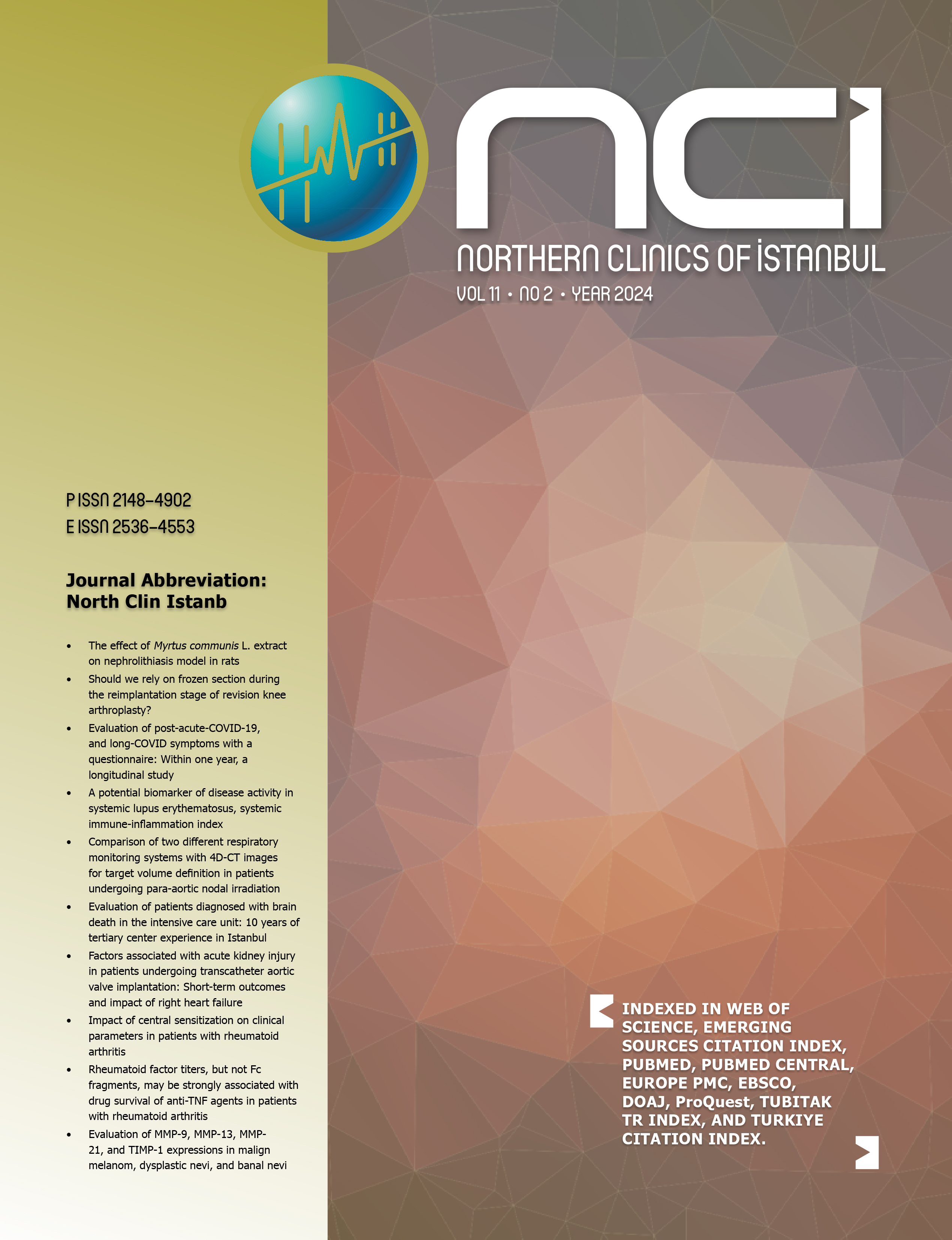Examination of osteosarcopenia in patients over 65 years old with hip fracture
Suheda Cakmak1, Ismail Turkmen2, Fatma Kulali3, Necdet Saglam4, Selda Cakin Unnu1, Sema Ucak Basat11Department of Internal Medicine, University of Health Sciences, Umraniye Training and Research Hospital, Istanbul, Turkiye2Department of Orthopaedics and Traumatology, Istanbul Medeniyet University, Goztepe Prof. Dr. Suleyman Yalcin City Hospital, Istanbul, Turkiye
3Department of Radiology, University of Health Sciences, Umraniye Training and Research Hospital, Istanbul, Turkiye
4Department of Orthopaedics and Traumatology, University of Health Sciences, Umraniye Training and Research Hospital, Istanbul, Turkiye
OBJECTIVE: There is limited knowledge regarding the clinical, biochemical, and functional characteristics of patients with osteosarcopenia. The present study aims to explore the presence of osteosarcopenia in patients aged 65 years and over who have a history of falls and hip fractures.
METHODS: Seventy-six participants (77.6% women) aged 65 years and over (mean age 81±6.75 years) who were admitted to the orthopedic clinic of our hospital due to hip fracture. The diagnosis of osteopenia/osteoporosis was established based on the bone mineral density measurement using the dual-energy x-ray absorptiometry. The SARC-F scale was used to screen patients for sarcopenia. The muscle mass was determined by the appendicular lean mass (ALM). The muscle strength was evaluated by the handgrip strength. SPSS for Windows 25.0 (IBM Statistical Package for Social Sciences) software package was used in the statistical analysis of the study data.
RESULTS: A total of 76 patients were evaluated, including 59 (77.6%) females and 17 (22.4%) males. The mean age of the patients was 81±6.75 years. The prevalence of osteosarcopenia in the entire study group was 36.8%. The prevalence rate was higher in males (59%) than in females (30.5%) (p<0.05). The ALM and the handgrip strength were lower in patients with osteosarcopenia (p<0.05). The mean body weight, total fat mass, fat mass index, and upper arm circumference were the lowest in the group of patients with osteosarcopenia (p<0.05).
CONCLUSION: The present study found that the prevalence of osteosarcopenia was higher in patients with hip fracture. There is a limited number of studies in literature directly evaluating the relationship between osteosarcopenia and hip fracture. The presence of osteosarcopenia is often overlooked when the bone fracture is the prevailing clinical condition. Osteosarcopenia is frequently the accompanying diagnosis in patients with hip fracture.
Keywords: Hip fracture, osteoporosis; osteosarcopenia.
65 yaş üzerindeki kalça kırıklı hastalarda osteosarkopeni incelenmesi
Suheda Cakmak1, Ismail Turkmen2, Fatma Kulali3, Necdet Saglam4, Selda Cakin Unnu1, Sema Ucak Basat11Sağlık Bilimleri Üniversitesi, Ümraniye Eğitim ve Araştırma Hastanesi, İç Hastalıkları Kliniği, İstanbul2İstanbul Medeniyet Üniversitesi, Göztepe Prof. Dr. Süleyman Yalçın Şehir Hastanesi, Ortopedi ve Travmatoloji Kliniği, İstanbul
3Sağlık Bilimleri Üniversitesi, Ümraniye Eğitim ve Araştırma Hastanesi, Radyoloji Kliniği, İstanbul
4Sağlık Bilimleri Üniversitesi, Ümraniye Eğitim ve Araştırma Hastanesi, Ortopedi ve Travmatoloji Kliniği, İstanbul
AMAÇ: Osteosarkopenili hastaların klinik, biyokimyasal ve fonksiyonel özellikleri ile ilgili bilgiler sınırlıdır. Bu çalışma, düşme ve kalça kırığı öyküsü olan 65 yaş ve üstü hastalarda osteosarkopeni varlığını araştırmayı amaçlamaktadır.
YÖNTEM: Hastanemiz ortopedi polikliniğine kalça kırığı nedeniyle başvuran 65 yaş ve üstü (ortalama yaş 81±6.75 yıl) 76 katılımcı (77.6% kadın) mevcuttu. Osteopeni/osteoporoz tanısı, ikili enerji x-ışını absorpsiyometrisi kullanılarak yapılan kemik mineral yoğunluğu ölçümüne dayalı olarak konuldu. Hastaları sarkopeni açısından taramak için SARC-F ölçeği kullanıldı. Kas kütlesi, apendiküler yağsız kütle (ALM) ile belirlendi. Kas kuvveti el kavrama kuvveti ile değerlendirildi. Araştırma verilerinin istatistiksel analizinde SPSS for Windows 25.0 (IBM Statistical Package for Social Sciences) programı kullanılmıştır.
BULGULAR: 59 kadın (%77,6) ve 17 erkek (%22,4) olmak üzere toplam 76 hasta değerlendirildi. Hastaların yaş ortalaması 81±6,75 idi. Tüm çalışma grubunda osteosarkopeni prevalansı %36.8 idi. Prevalans oranı erkeklerde (%59) kadınlardan (%30,5) daha yüksekti (p<0,05). ALM ve el kavrama kuvveti osteosarkopenili hastalarda daha düşüktü (p<0.05). Ortalama vücut ağırlığı, toplam yağ kitlesi, yağ kitle indeksi ve üst kol çevresi osteosarkopenili hasta grubunda en düşüktü (p<0,05).
SONUÇ: Bu çalışmada kalça kırığı olan hastalarda osteosarkopeni prevalansının daha yüksek olduğu bulundu. Literatürde doğrudan osteosarkopeni ile kalça kırığı arasındaki ilişkiyi değerlendiren sınırlı sayıda çalışma bulunmaktadır. Osteosarkopeninin varlığı, kemik kırığı hakim klinik durum olduğunda sıklıkla göz ardı edilir. Osteosarkopeni, kalça kırığı olan hastalarda sıklıkla eşlik eden tanıdır. (NCI-2023-2-12)
Anahtar Kelimeler: Kalça kırığı, osteoporoz; osteosarkopeni.
Manuscript Language: English





















